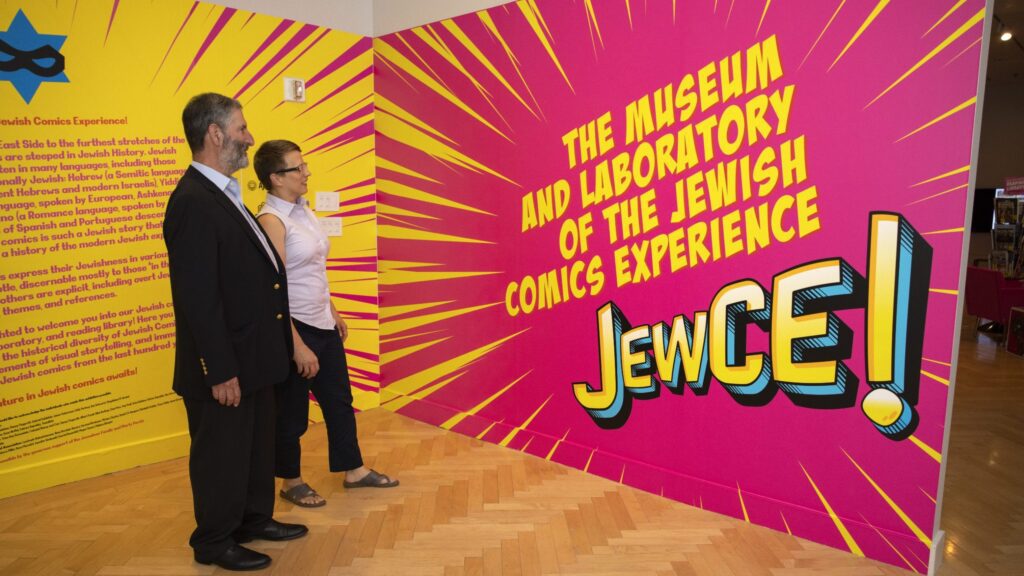Jew:CE The Jewish Comics Experience
By • December 5, 2024 0 476

By Sheila Wickouski
Superman, Batman, Wonder Woman—these are some of the stars in the exhibit Jew:CE The Jewish Comics Experience at the Lillian and Albert Small Capital Jewish Museum, which runs through March 23, 2025.
Simultaneously bold, funny, inspiring and entertaining, this popular media of comics blends political issues dressed in stories which captured daring adventures of superheroes faced with overwhelming crisis in human welfare.
Spanning over 100 years, the exhibit begins with a background of Yiddish humorous politically-focused cartoons from the late 19th century, setting the stage for what is to come. “Nyu-yorker yidishe folkstasaytung, New York” is one example of a late 19th century political cartoon, which depicts Tsar Aleksander III with a rooster body, suggesting that it would be good if the tsar would be sacrificed like the chicken on Yom Kippur for the the expiation of sins.
The Comic’s Industry’s blending of science fiction with romance begins with Superman, who crashed to earth in Action Comics #1 in 1938. Scholars have noted that Superman embodied the value of “tikkum olam,” in an effort to better the lives of everyday people.
Jerry Siegel and Joe Shuster’s character was a hit as soon as he hit earth and would soon be followed by other comic book stars.
Joe Simon, co-creator of Spider-Man, The Avengers, the X-Men, the Fantastic Four and The Hulk, summed it with a saying that world events created “the perfect a comic-book villain, Adolph Hitler, with his ranting goose-stepping and ridiculous mustache.” So they created the perfect hero to be his foil with Captain America. The comic book hero would punch Hitler on the cover of the first issue in December 1940.
While Superman would later be a movie hero, his first appearance in 1938 would lead to the role he played in the real world, when the U.S. government used him to promote military enlistment, blood donations, paper and metal drives, war stamps and bond sales.
Several themes are of particular note: A fictional Latina Hollywood starlet, Señorita Rio would be a U.S. spy in Latin America in the 1940s There was a series of Hebrew children publications in 1946-48. In 1950, Superman would be part of a team of heroes which included Batman, Wonder Woman, The Flash, Martian Manhunter, Green Lantern and Aquaman as the Justice League of America.
By the 1970s, graphic novels would widen the storytelling beyond the superhero saga to explore a wider area of complex themes. MAD Magazine comics and MetaMaus are part of this history as is Joannn Stars’ The Rabbi’s Cat (2002) which incorporates a spiritual journal through though-provoking questions of teachings and rituals of Judaism. Works by women graphic artists are also on display, most notably Carol Isaacs’ memoir The Wolf of Baghdad (2020),
The exhibit JewCE Te Jewish Comics Experience offers endless historical details to pursue but what all the works share over a hundred years —from the beginning of black and white cartoons to colorful graphic novels— is that comic book art engages the spirit. In the times of rising threatening regime to human rights issues, comic books with the positive endings of victory for the heroes, provided besides obvious escapism entertainment, the much needed hope and inspiration.
Combining images with the stories in a way that words alone can not do, what originated as accessible and affordable art thus offered a wide range of understanding of issues visually through symbolic images. These creations reached a wide audience from children to adults and remain for many of us in memory years later.

